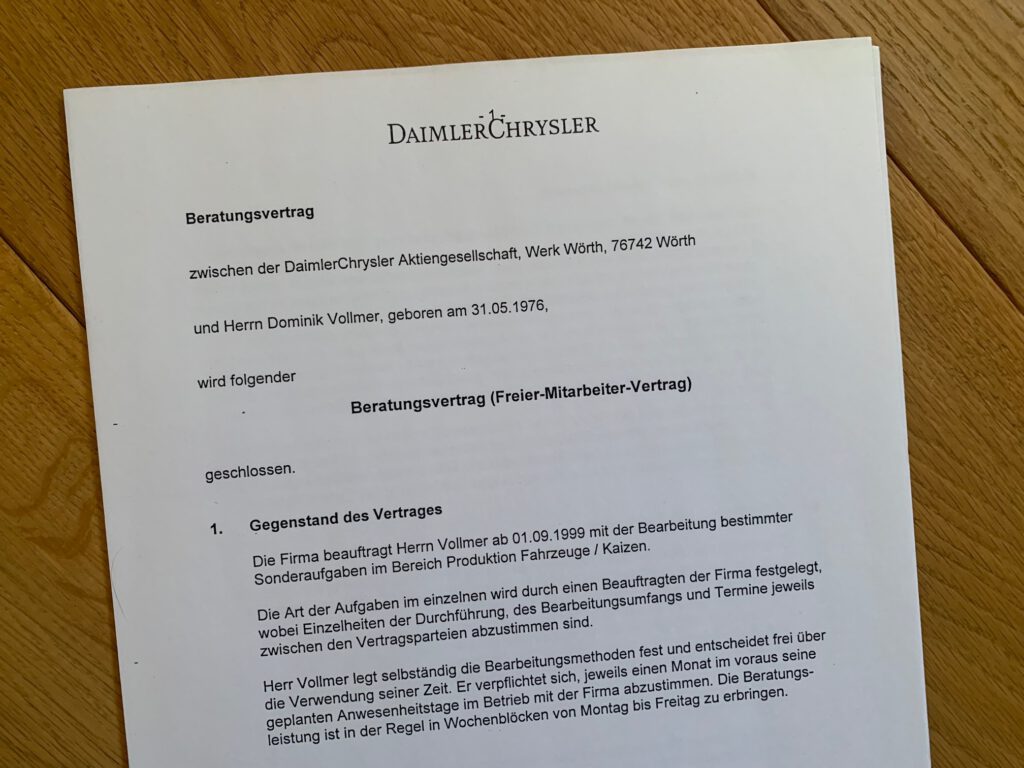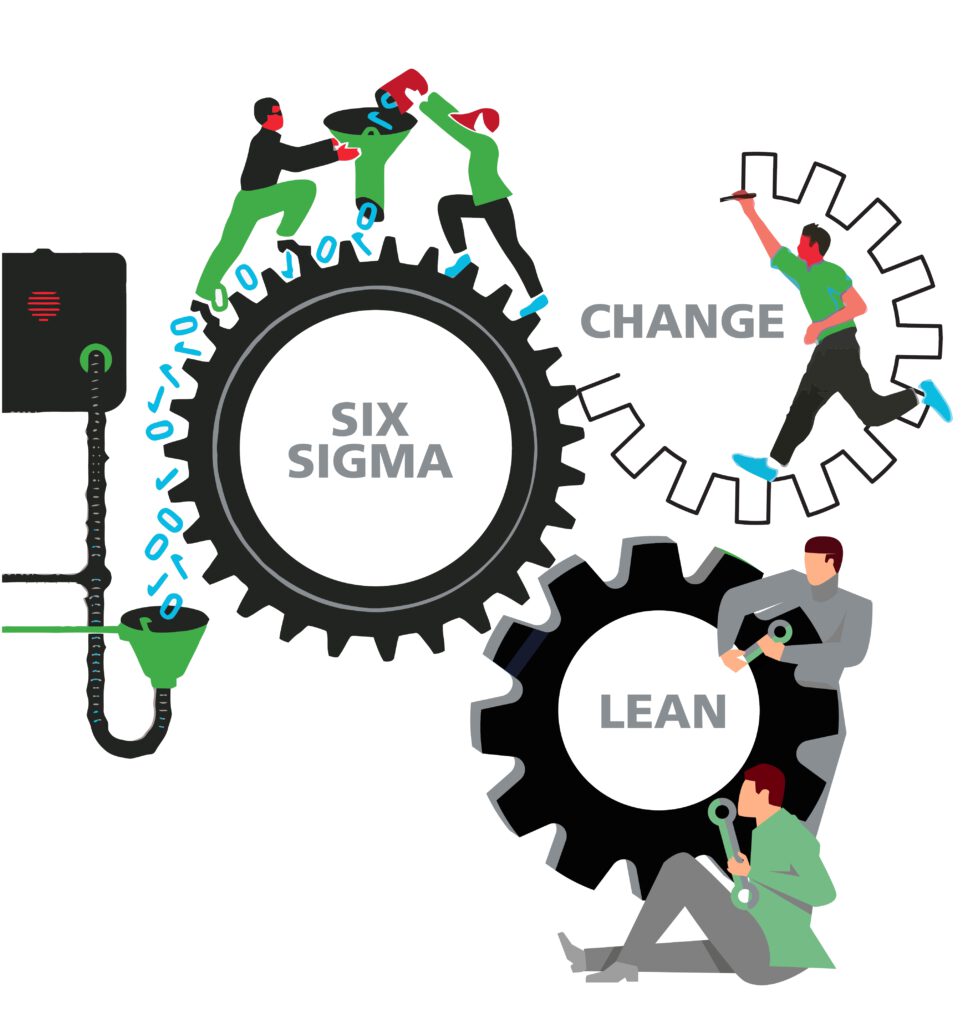How does a passion for problem solving get you from the deepest Black Forest to the Swabian automotive capital?
My name is Dominik, I grew up in a small village in the Kinzigtal in the Black Forest and founded Six Sigma-Lean Consulting in Stuttgart in 2013.
From an early age, I had an entrepreneurial spirit and a certain penchant for the complicated:
For example, as a high school student I started doing tricky work for a local computer company, assembling computer systems for local businesses and individuals, and quite often doing tricky repairs. I always liked solving problems and was really good at it: after a while, I realized that I could run a business like that on my own - so I started my own first business as a student.
During my studies of industrial engineering at the University of Karlsruhe, I spent, among other things, a year abroad in Lyon, enjoyed the benefits of the South of France and had a good connection to the French and their culture. Perhaps this is one of the reasons why Xavier and I are such a good match on a personal level.
The dream of many southern Germans to work at Daimler or Porsche...
...prompted a good friend back then to point me to an exciting internship position at the then Daimler-Benz AG during my undergraduate studies. There I was confronted with Lean Management for the first time. At that time, nobody there called it "Lean" but "KAIZEN" - which is Japanese and can be translated as "the action of making bad things better".
By chance, I got to know that the department head of the division had commissioned several professional video studios to make a backup copy of a wickedly expensive KAIZEN training film, which was equipped with an appropriate protection mechanism. None of the highly specialized companies were able to make an error-free copy of the video. Thanks to the experience gained through my computer company, I solved the problem two days later by digitizing the film with the help of a new type of graphics card and then writing it back to an analog medium - a technique that was not yet available in any video studio at the time.
The copy was better than the original - and the head of department offered me a few months later to continue working for the "KAIZEN department" as a freelancer alongside my studies. I was proud to be the first student at the Mercedes plant to be offered a consulting contract as a freelancer.

Making complicated things simple: Less is more...
In this job, I was able to experience how you can achieve incredibly large leaps in productivity with very simple principles. How you can achieve a 50 percent improvement in a single week. How one week can change everything. I don't mean pointing out a potential improvement in one week. No, within one week everything was implemented.
To my astonishment, many improvements were achieved not by adding solutions, but by removing something existing from the process and thereby significantly simplifying the processes. This realization had a strong impact on me and highly motivated me to pursue this approach later on.
Six Sigma culture change at strictly hierarchical large corporation?
I later started my professional life at the same company. My first job was as an in-house consultant at the Mercedes passenger car quality control center in Stuttgart. A few years later came the merger crisis with Chrysler and glaring quality problems in all production plants. I was allowed to complete a Black Belt qualification and prepared a concept paper for the introduction of Six Sigma at the corporate level.
At that time, DaimlerChrysler was ruled by division heads and was light years away from practicing such an approach on a large scale. I could not have known that, although still completely green behind the ears, I had laid the foundation for the later worldwide rollout of Six Sigma at Mercedes with my paper.

But this took time. As part of a Group-wide restructuring program, our in-house consultancy was dissolved and transferred to a central quality department whose goal was to establish Six Sigma and other problem-solving methods in the Passenger Cars division, first in Germany and then worldwide.
Together with my department head at the time, I was allowed to fly to Detroit to report on the "Black Belt Program" that had already been introduced at Chrysler. Today, thousands of employees are trained in Six Sigma. Although I often disagreed with the path taken, I was proud that the first concept paper for it came from my pen.
On the day Dr. Zetsche and all the board members decided to do this, I was allowed to be in the room. But I was not important enough to be allowed to present myself.

That should be the path I will follow for the rest of my life....
The Black Belt program at Mercedes was aimed at improving the quality of products and processes, and I was allowed to implement Six Sigma at Mercedes together with an external consultant for several years. His direct supervisor was Michael Harry, the "Father of Six Sigma", who according to Wikipedia is credited with developing the Six Sigma concept.
After a few highly exciting years, I wanted to learn more about Lean. Many of my department colleagues didn't think much of it because they simply didn't know it. Because, blinded by their daily work with highly analytical special tools, they completely underestimated the benefits of the simplest methods & principles.
In my previous work in KAIZEN, I had experienced the clout and breathtaking implementation speed of Lean. It was clear to me from the beginning that the combination of approaches had to lead to the greatest success.
When you meet people who share your passion, great things happen....
With this motivation, I moved to the Mercedes Benz Production System (MPS) division and, after completing a one-year Lean training course, was able to train employees and managers in Lean and accompany projects as an expert trainer and in-house Lean consultant. During this time, the foundation for my later partnership with Xavier and Andreas was laid.
I had met Andreas first. My first lean project was in Berlin and Andreas was working there. From the beginning I had great respect, he was further along than I was and a very valued colleague. When he started his own business a few years later, I admired his courage to leave Mercedes to put Lean Management into practice in hospitals. His decision at that time and his successes encouraged me 3 years later to do the same and start my own consulting company as well. Then 4 years later Xavier joined as a partner.
Like me, Xavier was an in-house consultant and trainer. What I did in the passenger car division, he did in the trucks. We were a very good fit right from the start: We had the same passion for Lean and Six Sigma and allied ourselves from the start to establish the combination of the two "at Daimler." Actually, our idea was to write down our experiences in a book. We wanted to bring the approach to the world. We never wrote the book, instead we work together today in our own company. With the same mission. Will the book still come? We'll have to wait and see.
Change management to move the most important element in any process
As Daimler Lean trainers, we were trained by an experienced psychologist to become systemic consultants. That was the turning point: Now we were not only Lean and Six Sigma enthusiasts, but also knew how to convince skeptics and move people. Change management was the missing ingredient. We were taught how to engage people emotionally - the most important element in any process - convince them, and use resistance as an opportunity to our advantage.
Resistance was "THE" problem we all couldn't solve until then! We were given techniques on how to get people to realize on their own that change brings benefits. How to activate positive thinking. How to create change momentum. This was the missing piece in our puzzle!

Can you win a tender as a one-man show against 10 large established companies?
Armed with all this knowledge, the time was ripe for Six Sigma Lean Consulting. It all started as a 'one-man-show' in search of the first big customer. That was Festo. That was not to be thought of. Festo had already successfully practiced Lean and Six Sigma in production - and the idea was now to implement "Lean Sigma" in the administrative area as well. To this end, there was a call for tenders to which 10 applicants were invited. Among them were all the major established Lean Six Sigma training and consulting companies in German-speaking countries. And me as a one-man-show and completely unknown outsider.
In the end, I won the tender and successfully carried out the assignment together with Festo Training & Consulting. To this day, I don't know exactly how I managed that. An employee later told me that the other applicants had primarily presented their trainings, since it was a training tender. To this day, I am convinced that training is only one component among many. In my concept, I showed instead how to select the right projects, tailor them, and reduce complexity in order to handle them successfully. And how to conduct training in such a way that the focus is not on training the participants, but on the success of the projects. That made all the difference - and Festo is still one of our most loyal customers today.
What am I proud of?
I am proud that all our customers who have ever commissioned us are still our customers. We have never lost a customer. 100% retention rate. That makes us all very proud.
We have a very cooperative relationship with all our customers. They know that we are highly motivated to make Lean Six Sigma a success in their companies - and do everything we can to make it happen. That's what drives us.
Today, each of us coaches a three-digit number of projects per year - unless a pandemic or a potential world war intervenes. In the Daimler days, it was just one per quarter. We have learned to achieve a lot with a small amount of resources.
Problem solution with €15 million savings
A paint manufacturer had engaged 2 institutes - and tried unsuccessfully for years to solve a highly complex problem in production. With the help of Lean Six Sigma, we were able to solve it after a few months - but mainly with change management. It was a real tour de force: The biggest problem was not the complexity of the problem, but that the employees themselves did not initially believe they could solve it at all. Cracking this "nut" was more difficult than the actual technical problem. In the end, we saved over 15 million euros. This customer has since decided to take Lean Six Sigma mainstream. You can't have a better starting point for the Lean Six Sigma rollout. And I am very proud of that.
Of course, I work not only...

I am married, have a wonderful wife, Anja, who, by the way, takes care of our entire back office and watches our backs every day when we are with customers, even though she never learned that professionally. And two wonderful children, Jannis and Lea. We all have a passion for South Africa and look for every opportunity to spend time there. It's our sanctuary when work gets on top of us ... and our inspiration and zest for life.
We play tennis and table tennis, we ski, we play chess ...and always have a lot of fun doing everything together. Jannis is 10 years old and now designs Lego models that are sometimes better than Lego.
Our 8-year-old Lea is crazy about animals through and through and has been dreaming of her first dog or pet since she was born, it feels like. The former will remain a dream - we see absolutely no room for a dog in our city apartment. But sometimes dreams become reality: Since recently we are the proud owners of 2 Korat kittens, who, thanks to their Thai dynamics & climbing skills, present us with new challenges in everyday life almost every day - and which we have always been able to solve successfully so far!
Speaking of everyday life: Xavier's and my mission is, Bringing people together with solutions by making complicated things simple - in everyday life as well as at work!
We want to give back to the community and help businesses and individuals understand the benefits of problem solving with Lean Management and Six Sigma principles & tools.




